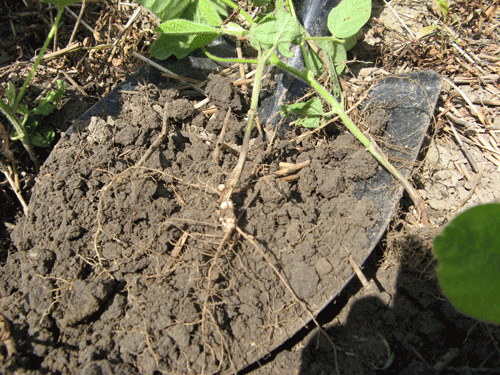Soybean inoculants provide returns
RECENT RESEARCH SHOWS THAT APPLYING SOYBEAN INOCULANTS YEARLY MAY BE BENEFICIAL TO FARMERS
Using soybean inoculants pays returns to producers, says a three year study by OMAFRA and the University of Guelph. It’s well understood that when growing soybeans for the first time in any given field, treating seeds with an inoculant is one of the keys to success.
But once the nitrogen fixing bacteria are established in the soil, as occurs when soybeans have been planted previously in a field, they will survive in the ground for many years. Therefore, conventional thinking has been that there is little or no yield gain to inoculating every time a soybean crop is grown after the initial application. Research conducted with older inoculant formulations confirmed that yield gains were inconsistent if the field had successfully grown soybeans in the past. However, new Ontario research now shows that things have changed.
Technological Progress
Advances in inoculant formulations have provided new technologies collectively called “pre-inoculants.” These products contain highly efficient strains of bacteria and “extenders” that prolong the viability of inoculants on the seed, making it possible for seed to be treated before it is delivered to the farm.
Elimination of the need to apply the inoculants on farm immediately before planting is a useful convenience to the producer, and the superior coverage achieved by a commercial applicator is also an important advantage. These high quality inoculants provide between 800,000 and 1,400,000 bacterial cells per seed, much higher concentrations than were previously achievable with drill box applications.
Reviewing the Research
Researchers from Ohio State University found yield gains to be common in productive fields with a history of soybeans. The average yield response from 64 Ohio trials was 1.9 bushels per acre from all inoculants tested. At a cost of $3.00 to $5.00 per acre (depending on the seeding rate and product used) a half bushel per acre yield increase could be considered “break even”.
A profit of 300 percent, compared to the investment when using an inoculant is possible, according to Ohio researchers. Some states, such as Michigan and Indiana, have also found average gains ranging from 1.0 to 1.3 bushels per acre in fields with a history of soybeans. Other regions especially those further west have found little or no significant yield gains.
Thirty-eight replicated field trials were conducted in Ontario from 2007 to 2009 to assess the efficacy of two common pre-inoculant products in fields with a history of soybeans. A variety of soil types, yield potentials, crop rotations, and environments were chosen and trials were replicated twice with a minimum length for each treatment of 1,000 feet. All trials included the following treatments:
1. Untreated Check
2. Cell Tech SCI
3. HiStick Liquid + Liquid Extender (2007)
HiStick L N/T (2008 – 2009)
Yield differences were found between the untreated soybean and those treated with an inoculant (See figure 1). The average yield gain of the inoculants compared to the untreated control was 1.25 bushels per acre across the three years. Although the difference was small, the large number of trials allowed the researchers to conclude that it was statistically significant, with a confidence level of over 99.9 percent.
In 2009 a slightly larger yield response of 1.8 bushels per acre was found. This is probably because of the cool growing season experienced in that year.
No performance difference was found between the two inoculants tested in these trials. At a selling price of $10.00 per bushel and a yield gain of 1.25 bushels per acre, a return of $8.75 per acre is realized when using an inoculant (assuming a cost of $2.50 per unit times 1.5 units per acre).

Explaining the Benefit
There are a number of factors that influence nodulation, nodual growth, and nitrogen fixation. These factors include too much or too little moisture, soil temperature, soil pH, diseases, organic matter and soil nitrate availability, as well as the rhizobial quality and bacterial strain in the soil. These potential problems may help to explain why adding new inoculants every year provides a yield benefit.
For example, in 2009, extremely cool temperatures along with excess moisture caused poor nodulation in many fields. Inoculant trials had greater returns this year than other years perhaps because of these stresses. A root zone temperature of 17°C seems to be the critical temperature for soybean nodulation and nitrogen fixation. Past experiments show that nodulation can cease when temperatures fall to 10°C and a root zone temperature of 15°C restricts both infection and nodule development and can delay the onset of nitrogen fixation by four to six weeks. In those experiments, plants with a root zone temperature of 15°C had only fixed nine percent of the nitrogen fixed by plants at 25°C six weeks after inoculation.
It’s obvious that a successful crop of soybeans can be grown without the use of an inoculant on history fields. However this study shows that, on average, inoculants provide an excellent return on investment. •







